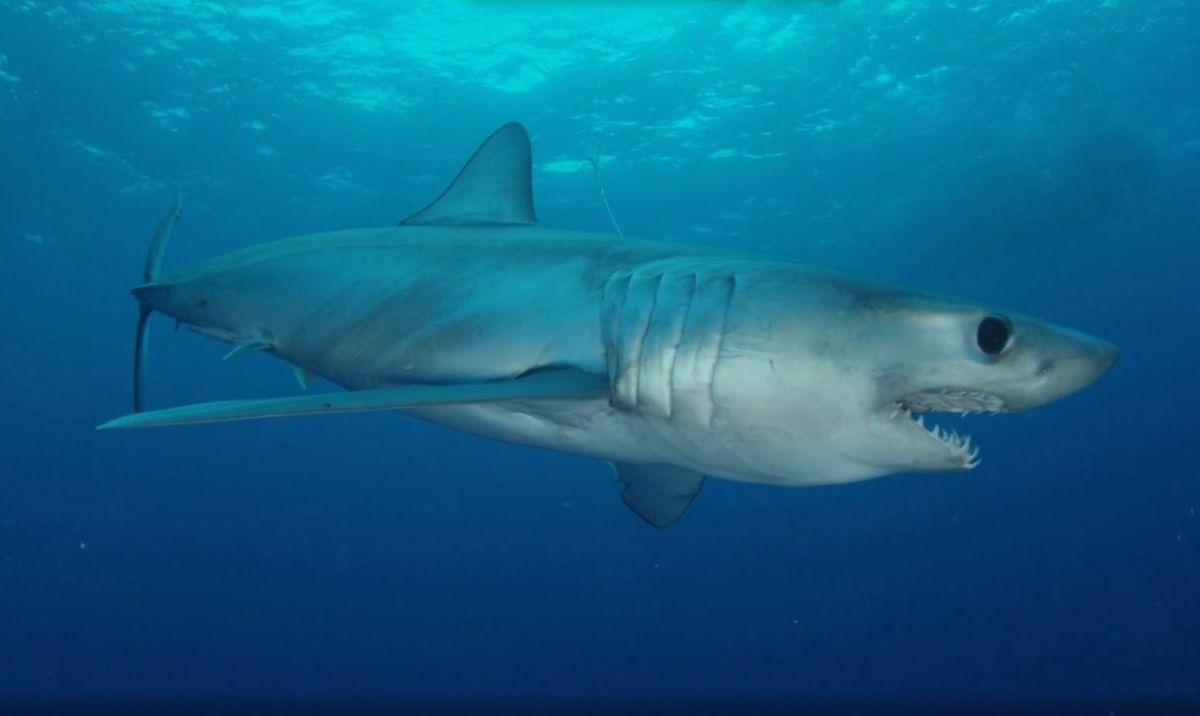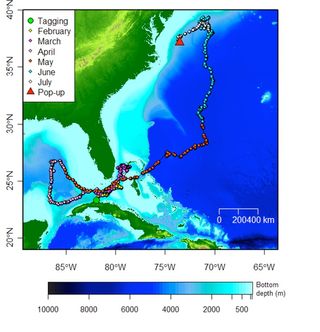Mako Shark Phones Home, Revealing Epic Journey

One of the toothy stars of "Shark Week" has phoned home after five months at sea, revealing that this longfin mako shark was a prolific and deep-diving swimmer.
On Valentine's Day, researchers from the United States and Cuba came together near Cojimar in northern Cuba to put a satellite tag on a rare longfin mako shark.
Remarkably, in the following five months, the mysterious deep-water shark swam 5,500 miles (8,850 kilometers), averaging 36.5 miles (58.7 km) a day. In April, the animal followed the Gulf Stream west into the Gulf of Mexico, then looped back north and east through the Bahamas in May, and into the deep Atlantic Ocean. In June, the shark circled as far north as the coast of New Jersey, before traveling southeast toward Virginia's Chesapeake Bay. There, the animal's satellite tag detached (as it was programmed to do) in mid-July and started calling in the shark's travelogue, to the excitement of the researchers. [Gallery: World's Sharks Captured in Underwater Photos]
This was the first longfin mako ever tagged in Cuban waters, the researchers said, but the animal's path looked strangely familiar.
"The amazing thing is this longfin mako's tag popped up in nearly the same exact location as another one we tagged in the northeastern portion of the U.S. Gulf of Mexico a few years ago," expedition member John Tyminski, a fisheries biologist at Mote Marine Laboratory in Sarasota, Florida, said in a statement. "Clearly there's something in that location that's attracting mature males in summer."
The researchers speculated that the sharks could have been traveling to this spot off the Eastern Seaboard to mate or feed, or the animals were just passing through on their way to points unknown.
The shark also shocked researchers with deep dives of up to 5,748 feet (1,752 meters) — more than a mile below the surface of the ocean.
Sign up for the Live Science daily newsletter now
Get the world’s most fascinating discoveries delivered straight to your inbox.
"At that depth, the shark is dealing with extreme cold, close to freezing," expedition member Robert Hueter, director of the Center for Shark Research at Mote, said in the statement. "The data from this tag will help us understand why these sharks are diving so deep and how they are dealing with such cold temperatures."

Precious little is known about the longfin mako, a deep swimmer whose movements are hard to track. First described in 1966 by Cuban marine scientist Dario Guitart Manday, longfin makos typically measure 7.2 feet (2.2 m) in length and weigh 150 lbs. (70 kilograms), though one 14-foot-long (4.3 m) female was caught off the coast of Florida in 1984.
The longfin's close relative, the shortfin mako, is thought to be the world's fastest shark, capable of speeds of up to 62 mph (100 km/h). Makos are also thought to be the closest evolutionary relative of their larger cousin, the great white shark.
The longfin mako's grand journey is a reminder that the ocean connects many nations, the researchers said.
"The fact that these sharks go back and forth among the waters of multiple nations — in this case, Cuba, the United States, the Bahamas and Mexico — shows the importance of coordinating our fisheries sustainability and conservation efforts on a multilateral, even global scale," Hueter said in the statement. "Clearly it is important for the U.S. and Cuba to work together to protect vulnerable marine resources like these rare and depleted species of sharks."
Footage of the Cuban-American research team aired on Discovery Channel's "Shark Week" on July 7 in a program called "Tiburones: The Sharks of Cuba." An update on the shark's migration aired Aug. 30 at 7 p.m. EDT on Discovery's "Shweekend."
Follow us @livescience, Facebook & Google+. Original article on Live Science.
Most Popular

